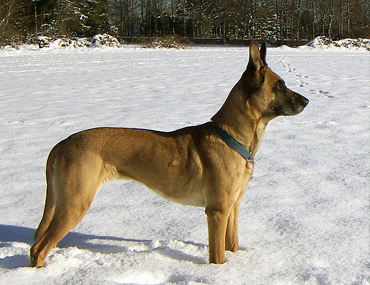Background:
The Belgian Malinois is named after a specific region in Belgium. Early Belgian Shepherd breeds were at one time all grouped together and very few breeding records were kept before the 1900s. It’s safe to assume that Malinoises were bred for functionality and not for aesthetics or dog shows.
In the late 1800s a renewed sense of Belgian pride led to a sudden interest in Belgian Shepherd heritage. Adolphe Reul studied the dogs and sorted them into four separate breeds. While the Malinois has always been very popular in Belgium, Americans had little interest in the breed until the end of World War II.
Having proved his usefulness during the war, the Malinois caught on as a police and military dog. It’s still rare to see a Malinois in the show ring but very possible you’ll see one in the back of a police cruiser or on a military base.
The American Kennel Club recognized the Malinois in 1911 but still maintains a different breed standard than in parts of the world where he is more popular.
Sizing up:
- Weight: 40 to 80 lbs.
- Height: 22 to 26 inches
- Coat: Short
- Color: Fawn/Mahogany
- Life expectancy: 12 to 14 years
What’s the Belgian Malinois like?
Consider that the Malinois is often used by both the police and the military. Why? Because the Malinois is a high energy dog who’s very easy to train. He would make an excellent companion for an avid biker or jogger but a poor choice for an owner who just needs to crash on the couch after work. His explosive energy must be directed towards something productive or he will spend his time chewing on furniture and barking. Perhaps the best way to tire him out is with games. The Malinois can be trained to jump through hoops, run an obstacle course, chase a Frisbee, or anything else where he can use his powerful legs. Be creative and have fun. Whatever you decide to play we advise having a fenced back yard to keep the Malinois from chasing after the first squirrel he sees.
The Malinois is a born watchdog, very protective of his family and wary of strangers. With that in mind early socialization is important to keep him from turning aggressive.
When it comes to training it’s important that the Malinois respects you. Be firm but never harsh. Use a clicker and food rewards every time he does something right.
Health:
When owning a Malinois you should consider the following potential health concerns:
- Epilepsy
- Cataracts
- Progressive retinal atrophy
- Hip dysplasia
- Elbow dysplasia
- Pannus
Takeaway Points:
- The Malinois is a working dog who loves to play.
- The Malinois will become destructive if not properly stimulated.
- The Malinois is an excellent watchdog.
- The Malinois has a strong prey drive so a fenced backyard is advised.
If you have any questions or concerns, you should always visit or call your veterinarian – they are your best resource to ensure the health and well-being of your pets.
